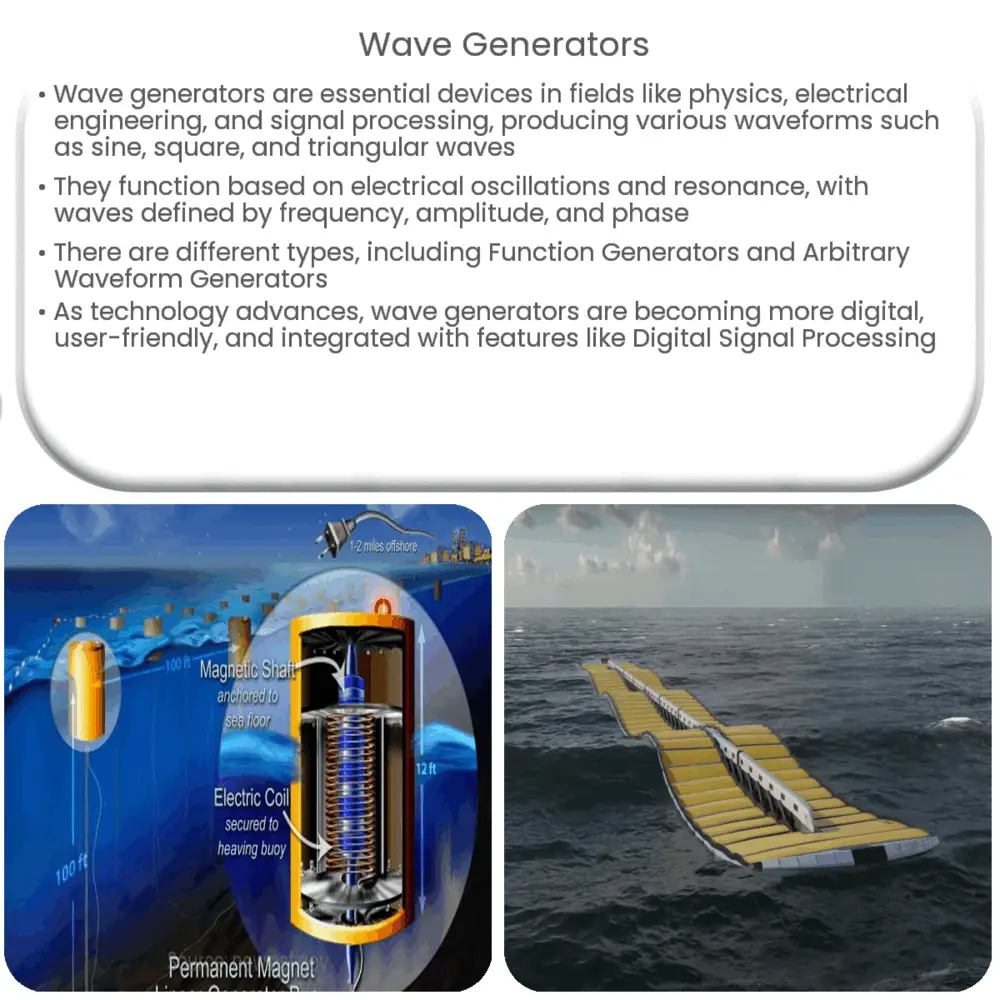Explore the world of wave generators, their types, fundamental principles, applications, and future prospects in our comprehensive guide.

Introduction to Wave Generators
A wave generator, commonly associated with physics, electrical engineering, and signal processing, is an essential device that produces various types of waveforms. These waveforms can be anything from sinusoidal (sine) waves to square, triangular, and complex custom waveforms.
The Fundamental Principles of Wave Generators
Wave generators function based on the principles of electrical oscillations and resonance. When an electrical charge is displaced from its equilibrium, the system’s inherent properties cause it to oscillate at specific frequencies. The waveform that this oscillation traces is what the wave generator captures and reproduces.
Importantly, wave generators can produce waves of differing frequency, amplitude, and phase. These three properties collectively define the specific characteristics of the generated wave. The frequency (f) determines the wave’s pitch in sound applications or its color in light applications. Amplitude (A) represents the wave’s intensity or loudness, and phase (ϕ) describes the wave’s alignment in time.
Types of Wave Generators
- Function Generators: These are versatile devices capable of producing a wide array of waveforms such as sine, square, and triangular waves. Function generators are commonly used in schools and laboratories.
- Arbitrary Waveform Generators (AWGs): AWGs have the unique ability to generate any waveform, as defined by the user. They’re used in advanced research and technology applications.
- Pulse Generators: As the name suggests, these generators produce pulse waveforms. They’re often utilized in testing digital and communication equipment.
- RF and Microwave Signal Generators: These generators produce high-frequency signals used in radio broadcasting and radar technologies.
Applications of Wave Generators
The versatile nature of wave generators makes them a crucial part of various fields. In electronics, they are used for testing circuits, calibrating equipment, and simulating specific signals. In audio engineering, wave generators can be used to synthesize sound or music. Moreover, in research and academia, they serve as an excellent tool for teaching students about wave properties.
Understanding Waveforms
Each type of waveform produced by a generator has its unique properties and applications. Sine waves are fundamental to physics, representing a smooth, periodic oscillation. Square waves, with their abrupt transitions, are commonly used in digital electronics. Triangular waves offer a linear rise and fall that’s useful in certain types of signal processing. Understanding these waveforms is crucial in harnessing the full potential of a wave generator.
Using Wave Generators
To make the most of a wave generator, it’s important to understand its operational parameters. Key among these are the waveform type, frequency, amplitude, and phase. These settings are typically adjustable on the generator, allowing users to tailor the output to their specific requirements. The user can manipulate these parameters either via knobs and dials on the device itself, or in some cases, through computer software that interfaces with the generator.
The Future of Wave Generators
As technology progresses, the features and capabilities of wave generators are continually advancing. Many modern wave generators can connect to computers, allowing for increased precision and ease of use. With software control, users can create complex, custom waveforms with a few clicks of a mouse. Looking forward, it’s anticipated that wave generators will become increasingly digital and user-friendly, with greater connectivity options and advanced features.
- Integrated Circuits: The rise of integrated circuits has made it possible to pack more functionality into smaller devices, and wave generators are no exception.
- Digital Signal Processing: Digital Signal Processing (DSP) techniques are becoming increasingly integral to wave generation, allowing for the creation and manipulation of complex waveforms with relative ease.
- Wireless Technologies: As wireless technologies continue to evolve, so too will the need for wave generators capable of testing and calibrating these technologies.
Conclusion
In conclusion, wave generators are a critical tool in a wide variety of industries and fields, from electronics and communications to research and education. Their ability to generate and manipulate different waveforms allows for the exploration and utilization of wave-based phenomena. As our understanding and technology continue to advance, wave generators will no doubt remain at the forefront of many scientific and engineering applications, contributing to the innovation and advancement of our world.

